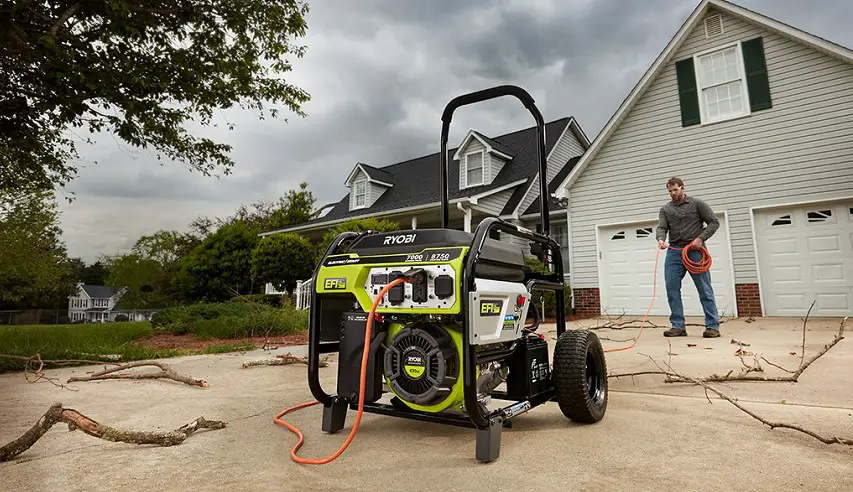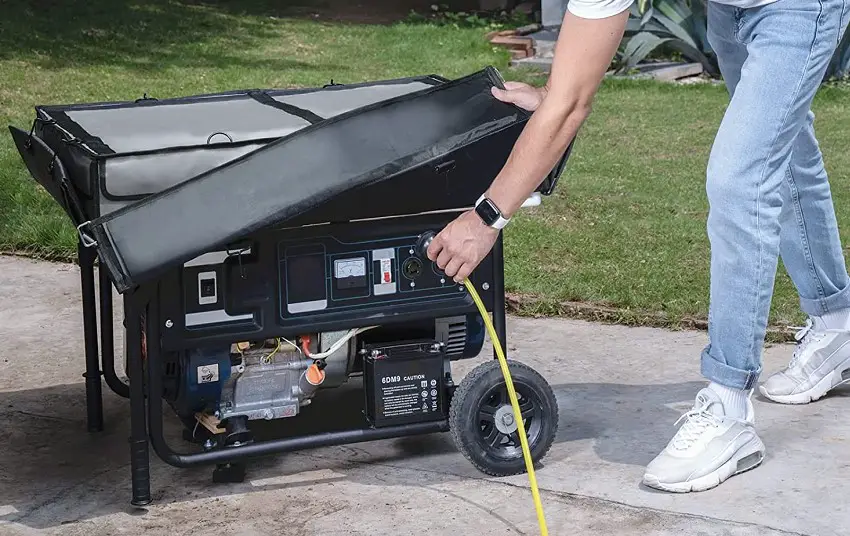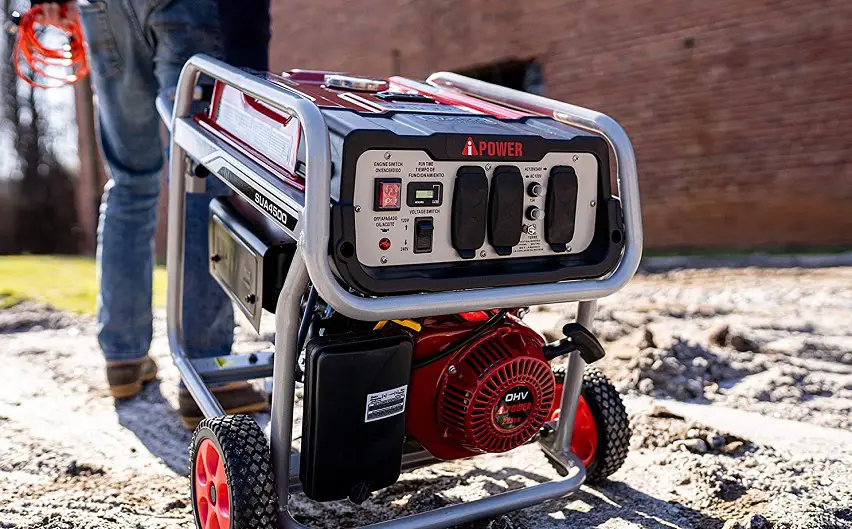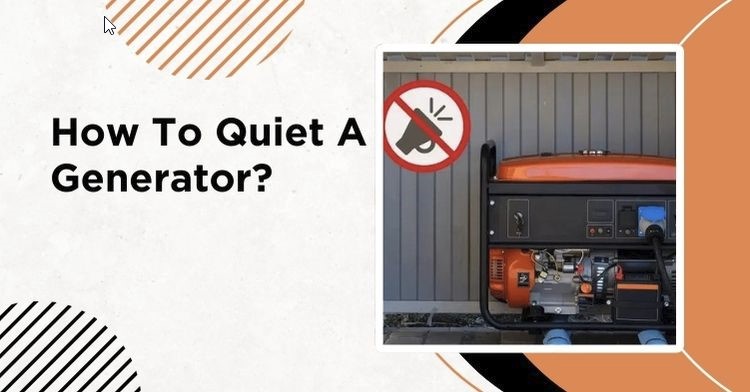How To Quiet A Generator Easily
The processes of converting one type of energy into another are accompanied by loud sounds. When playing a musical instrument, producing certain sounds (most of them pleasant) is the desired result.
When creating jet engines, jackhammers, and portable generators, sound, or more precisely, a noisy generator can cause considerable inconvenience in the operation of these products.
Therefore, the question of how to reduce generator’s noise is asked by many people. The problem is solved in two stages: first, scientists eliminate the noise from the main working mechanism and then make a generator quiet from the peripheral devices.
Performing good and proper noise isolation requires a certain level of professionalism. You will need the following tools:
- Washed wet sand
- Sandbags
- A 6-by-6-foot, two-compartment, fiberglass sound-reflecting screen
- Ultra-plastic urethane film (1/8 inch thick)
- Construction adhesive
- Fuel hose and clamps
- Tools for the job
Experts in many fields who work with generators admit that the sand method is one of the most effective methods of how to make a generator quiet.

Contents
- 1 Can you dampen the sound of a generator?
- 2 Is it worth solving the problem with the generator’s exhaust pipe?
- 3 What can I do with a portable generator?
- 4 Noise reduction steps for portable generators
- 5 How can I make my generator less noisy?
- 6
- 7 How relevant are these methods?
- 8 Installation of the unit in a noise-insulated room
- 9 Is it possible to make a generator quiet using a method of reducing non-desirable vibrations?
- 10 Which containers and materials should be used to make a generator quiet?
- 11 Easy way to make a generator quiet through silencers
- 12 What makes a generator so loud?
- 13 Conclusion
- 14 Frequently Asked Questions (FAQs):
Can you dampen the sound of a generator?
A generator produces a lot of noise, and you will be protected. Choosing the right place to install the generator is very important. It is best to place them in open areas rather than in garages, barns, and houses, which are effective acoustic propagators. In case, you can easily “calm down” the loud generator if you follow the following technical recommendations.

A flexible hose is used to redirect exhaust fumes. When soundproofing major sound sources, this hose allows the exhaust gases to overcome the entire layer of insulation materials and escape unhindered to the outside.
The flexible hose must be rigidly fastened.
Remove the fuel tank and install it separately from the generator in a shady and well-ventilated area. The tank should be placed above the level of the engine. Be sure to check that your fuel hose is long enough to reconnect the tank to the engine.
The fuel line can be routed underground in plastic tubing if the hose has no coupler connections. Metal and plastic tanks are very good sound amplifiers, so by insulating them from the alternator, you can greatly reduce the sound waves of the alternator with your own hands.

Is it worth solving the problem with the generator’s exhaust pipe?
For the exhaust pipe, you need to build a kind of existing muffler (in this case, we will consider the installation of a sound-absorbing screen). Make acoustic pads measuring 3 feet by 3 feet by folding in half the previously prepared fiberglass shielding material. Join the pieces together with glue using a hot glue gun.

Then, also using a glue gun, punch holes about four inches long in the top of the cushions. You will get open chambers that will need to be filled to the edges with sand. Finally, seal all the sections filled with sand with hot glue.
The presence of metal or plastic surfaces always contributes to additional noise. The portable generator contains a huge number of these surfaces. Clean them with solvent and, using contact adhesive, carefully coat them with polyurethane damping film.
Use sandbags to create an additional external soundproofing screen for making quiet a generator. Keep the bags at least one foot away from the generator. Stack them so that the generator is visible from at least four feet away.
Cover the sandbags with some sort of waterproof material to protect them from precipitation. This will also, help to understand how to quiet a generator.
When passing the exhaust pipe through sand-filled bags, you can also build sound-absorbing fiberglass baffles, as we have considered upper. Sometimes, however, the exhaust pipe is simply placed together with the generator inside a soundproof circle of bags.

What can I do with a portable generator?
A power generator can help you when disaster strikes or other emergencies arise, but constant noise can be detrimental to your health.
Studies have shown that loud, prolonged noises increase the risk of heart attack, destroy concentration, and make quality sleep impossible.
Noise from an alternator comes from two places: the exhaust system and vibrations in the engine case. You can modify the exhaust pipes to make them more efficient and create an enclosure around the generator that allows it to “breathe” for cooling air while limiting noise.

Noise reduction steps for portable generators
Each of the following steps will reduce noise differently and will help to get a silent generator. If you do everything, your portable generator will be significantly quieter during use.
Step 1: Adding A Spacer

Decide where you want the generator to stay. Place it as far as possible from the structure you are trying to power, such as your home or recreational vehicle, to reduce the noise you will hear. Then put the rubber pads on the ground and set the generator on them.
Step 2: Install Exhaust Pipes

A motorcycle exhaust is recommended to replace the exhaust on your alternator. You can easily find these at your local motorcycle store in small quantities, as most riders prefer custom exhausts. You will need to build your pipe system to attach it, and the exhaust pipes should be vertical to the alternator.
Step 3: Add Anti-vibration To The Engine Case

To achieve maximum reduction of engine noise, sound deflectors should be used, for which sound and vibration dampening material is used on the engine block.
Stock screws usually have a rubber washer already attached for noise reduction, but you can double that by adding another rubber washer and longer bolts. If you look at the frame around the motor, you’ll see how to attach it.
You’ll need to unscrew one spare bolt, replace it with a new bolt, and add a rubber washer on the outside of the metal washer so that the frame is sandwiched between the rubber.
From left to right – bolt head, metal washer, rubber washer, frame, rubber washer, metal washer, and bolt. Repeat this for all frame bolts and tighten them securely.
Step 4: Building The Baffle Box

Next, you will need to build a soundproof generator box enclosure around the generator. Walls should be on three sides of the generator, with switches and connections on the open side for easy access.
The galvanized block is the best material for the baffle box because it does not need to be sealed. Keep it stacked one foot higher than the generator, and leave a break of six inches to one foot between the generator and the baffle box.
Test your generator by turning it over and sitting in your house to see how much more sound it makes. If you are still not satisfied with the result, add a little more insulation to the ash block walls to see if it improves.
How can I make my generator less noisy?
As has been found in numerous studies, noise from a running generator is transmitted in two ways: through the air and vibration by contact with other surfaces. This should be taken into consideration to understand how to quiet a generator.
According to the data, a diesel-generating set emits sounds of up to 100 dB. If you compare this level with other objects, on average, it is equal to the noise of five cars passing within a kilometer of your house.
To reduce it, companies have developed various recommendations, beginning with sound deflectors and ending a building of own baffle box.
Its complex using which can achieve a reduction of noise by a factor of five! But to do this, all paths of sound propagation from the running installation should be blocked.
Experts distinguish two such groups of methods:
- Global noise suppression methods.
- Installation of the unit in a separate building.
How relevant are these methods?
The first one is optimal for large enterprises, which can use freestanding buildings or have enough money to construct a new facility. For this project, it is best to use sound deflectors which have increased sound insulation, in the construction of the facility.
However, this method is not suitable for domestic consumers because of the serious financial investment. The second method is available everywhere and is used quite often.

Installation of the unit in a noise-insulated room
This method is used much more often because it is easier to implement. In the room adapted for the installation of a diesel generating unit, a set of finishing works to improve its soundproofing characteristics is carried out.
Non-flammable mineral wool can be used as improvised materials: it can reduce the noise level by a quarter. Foam plastic or wall paneling can also be used.

Is it possible to make a generator quiet using a method of reducing non-desirable vibrations?
The structure of the power plant creates vibrations that are transmitted through the floor to the walls and cause noise.
To reduce these mechanical waves, the manufacturer uses special shock absorbers, which may lead to the generator producing a little bit less generator noise.
However, for making the generator quieter are soundproofing covers that create an additional sound barrier around the equipment. Such a device is manufactured in the factory with all the necessary options.

Which containers and materials should be used to make a generator quiet?
Due to the effective noise minimization, a diesel generator in this design can also be operated outdoors, but only in optimal temperature conditions:
- Steel housing clad on the inside with non-combustible materials.
- Technical openings and doors with locks.
- Inspection opening for access to the control panel.
- The muffler with a vibration-resistant flexible adapter.
- Special noise-cutting chambers on the side of the inlet and outlet ports will make a generator quiet.
All-weather containers are used for outdoor installation to suppress noise and protect equipment from atmospheric precipitation and low temperatures.

Their main difference from sound enclosures is easier access for servicing the unit. Their main advantages are:
- no heavy financial outlay;
- easy transportation without complicated installation work;
- excellent retrofitting and accessory options;
- no freestanding building or space requirement.
Containers are also prefabricated and come in a variety of sizes. Accordingly, there are two types of enclosures:
- Externally serviced containers or mini-containers.
- Internally serviced or full-size containers.
Full containers have access to the inside of the structure, where various service or repair activities are performed. There is no access to mini-containers.

Easy way to make a generator quiet through silencers
To install silencers is quite simple, some models may provide the installation of not one but several “mufflers” at once. According to the principle of operation, the generator muffler is identical to the car muffler.
It reduces the sounds of the generator’s exhaust system by dissipating energy in special chambers and employing tubular baffles, thereby delaying the sound waves that cause resonance.
The right choice of this device, depending on the type of the device and its power, can reduce the noise level of the generator by 49 dB.
Silencers have different degrees of noise limiting and are divided into devices:
- Industrial with a low degree. Optimally suited for use in industrial areas where the overall noise level is already high.
- For residential areas with moderate degrees. Allow you to reduce the sound level by 29 dB.
- Critical with a high degree. It is necessary to apply in residential areas.
The advantages of this method include low financial costs for its execution, the flexibility of installation, as well as various solutions for the installation site.

What makes a generator so loud?
Many factors influence silent generators, but we can identify several main causes that directly cause noise.

The first reason is the usual vibration. To get rid of it, or at least to reduce the mind a little bit, it is necessary to put the design correctly.
Note that the unit should stand on a completely flat surface, and under it should be put a rubber mat, which will reduce the vibration and, accordingly, the sound produced. In addition, it is necessary to move the device from the walls, and furniture.
In addition, carry out the isolation of the exit pipe for the exhaust with a special soft gasket.
The second cause of exhaust noise is the exhaust system. Usually, the technique is already equipped with a great muffler, but it can be replaced or improved if necessary for making quiet a generator.
The third factor is the cooling system. Everyone knows that air cooling makes loud noises, which can be eliminated by a protective cover with special grilles that absorb the sound.
You can install the equipment in a special soundproof room or build the cover yourself. But the specialists of the company have already thought about it and now, together with the installation, you can buy a professional modern eurocasing that will provide quiet operation of the unit.

Conclusion
Silent generator – the key to healthy nerves, psyche, and no complaints about its owner. If you are not lucky enough to own a quiet generator, you can always resort to the help of technical devices, homemade installations, and changes in internal configurations so that you do not have to return to the question of how to quiet a generator.
Frequently Asked Questions (FAQs):
How can I make my generator quieter?
Invest in a soundproof enclosure or box, add insulation to the generator housing, place the generator on a vibration-absorbing pad, and position it away from living areas to reduce noise levels.
How to make a silencer for a generator?
Constructing a silencer for a generator involves using materials like PVC pipe, fiberglass insulation, and metal mesh to absorb and reduce exhaust noise. It’s crucial to ensure proper sealing and compatibility with the generator’s exhaust system for effective noise reduction.
How effective are DIY methods for reducing generator noise?
DIY methods can be effective to some extent, but their effectiveness may vary depending on factors such as the generator model, noise level, and environmental conditions. Experiment with different techniques to find what works best for your situation.
Is it safe to modify my generator to reduce noise?
It’s important to be cautious when modifying your generator, as some alterations could affect its performance or safety. Consult the manufacturer’s guidelines or seek professional advice before making any modifications.
Can I use household items to quiet my generator?
Yes, you can use household items like foam panels, rubber mats, or blankets to dampen the noise from your generator. However, ensure they are fire-resistant and don’t obstruct airflow around the generator.


